Today, the new wheat rate in Pakistan is between 3,200 to 3,800 Rs. The price of 1 KG wheat is 88 Rs. Control price of wheat from the government is 2,850 Rs per 40 Kg. But due to lack of control on the price of wheat by the government of Pakistan, the price of wheat is lower than the control price.
In every city, the wheat price is different, so farmers are confused about the price updates. Now Pakistani farmers can be up to date about wheat prices. Kissan Shop updates the daily wheat rate in Pakistan. Today wheat price in Punjab, Sindh and KPK is following:
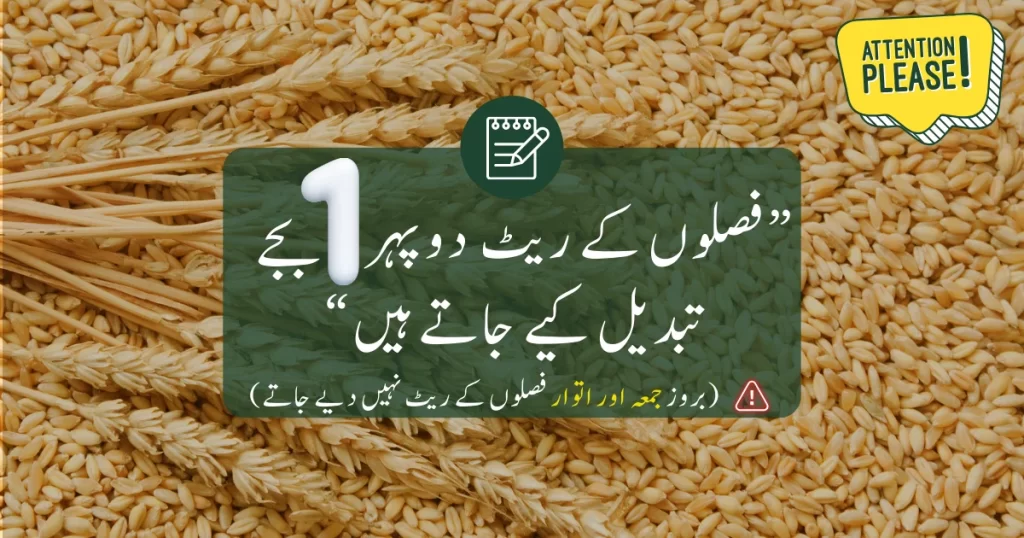
September 2025
Today Wheat Rate in Punjab
The latest wheat rate in Punjab’s cities starts at 3,200 Rs and ends at 3,800 Rs per 40 KG. In previous days, the wheat price crashed badly, but now it’s recovering a little bit.
| District / City | New Wheat Minimum Rate | New Wheat Maximum Rate |
|---|---|---|
| ???? Punjab | ||
| ArifWala (عارف والا) | 3,240 PKR | 3,335 PKR |
| Ali Pur (علی پور) | 3,220 PKR | 3,310 PKR |
| AhmadPur Sharqia (احمد پور شرقیہ) | 3,240 PKR | 3,370 PKR |
| Bahawalnagar (بہاولنگر) | 3,200 PKR | 3,310 PKR |
| Bahawalpur (بہاولپور) | 3,220 PKR | 3,340 PKR |
| Bhakkar (بکھر) | 3,260 PKR | 3,380 PKR |
| Burewala (بورےوالا) | 3,220 PKR | 3,350 PKR |
| Chichawatni (چیچہ وطنی) | 3,250 PKR | 3,300 PKR |
| Chishtian (چشتیاں) | 3,240 PKR | 3,385 PKR |
| Chowk Azam (چوک اعظم) | 3,240 PKR | 3,380 PKR |
| Chakwal (چکوال) | 3,230 PKR | 3,380 PKR |
| Chowk Munda (چوک مُنڈا) | 3,260 PKR | 3,390 PKR |
| Dera Ghazi Khan (ڈیرہ غازی خان) | 3,270 PKR | 3,300 PKR |
| Dera Ismail Khan (ڈیرہ اسماعیل خان) | 3,260 PKR | 3,320 PKR |
| Dunga Bunga (ڈنگہ بونگہ) | 3,250 PKR | 3,300 PKR |
| Dunya Pur (دنیاپور) | 3,270 PKR | 3,390 PKR |
| Faisalabad (فیصل آباد) | 3,240 PKR | 3,310 PKR |
| Faqirwali (فقیروالی) | 3,250 PKR | 3,320 PKR |
| Fazil Pur (فضل پور) | 3,260 PKR | 3,310 PKR |
| Fortabbas (فورٹ عباس) | 3,260 PKR | 3,350 PKR |
| Gujranwala (گوجرانوالہ) | 3,200 PKR | 3,370 PKR |
| Haroonabad (ہارون آباد) | 3,400 PKR | 3,520 PKR |
| Hasilpur (حاصل پور) | 3,230 PKR | 3,380 PKR |
| Islamabad (اسلام آباد) | 3,750 PKR | 3,770 PKR |
| Kahror Pakka (کہروڑپکّا) | 3,260 PKR | 3,360 PKR |
| Khanpur (خان پور) | 3,290 PKR | 3,365 PKR |
| khanewal (خانیوال) | 3,260 PKR | 3,320 PKR |
| Layyah (لیہ) | 3,270 PKR | 3,320 PKR |
| Lahore (لاہور) | 3,450 PKR | 3,600 PKR |
| Lodhran (لودھراں) | 3,230 PKR | 3,320 PKR |
| Maroot (مروٹ) | 3,230 PKR | 3,380 PKR |
| Multan (ملتان) | 3,360 PKR | 3,440 PKR |
| Mianwali (میانوالی) | 3,250 PKR | 3,310 PKR |
| Mian Channu (میاں چنّوں) | 3,230 PKR | 3,370 PKR |
| Minchanabad (منچن آباد) | 3,200 PKR | 3,320 PKR |
| Muzaffargarh (مظفر گڑھ) | 3,270 PKR | 3,300 PKR |
| Malsi (میلسی) | 3,250 PKR | 3,320 PKR |
| Okara (اوکاڑہ) | 3,260 PKR | 3,330 PKR |
| Pattoki (پتّوکی) | 3,270 PKR | 3,340 PKR |
| Pakpattan Sharif (پاک پتن) | 3,250 PKR | 3,370 PKR |
| Rahim Yar Khan (رحیم یار خان) | 3,250 PKR | 3,350 PKR |
| Rajanpur (راجن پور) | 3,380 PKR | 3,420 PKR |
| Rawalpindi (راولپنڈی) | 3,700 PKR | 3,740 PKR |
| Sadiqabad (صادق آباد) | 3,250 PKR | 3,340 PKR |
| Sahiwal (ساہیوال) | 3,270 PKR | 3,350 PKR |
| Sargodha (سرگودھا) | 3,360 PKR | 3,420 PKR |
| Sheikhupura (شیخوپورہ) | 3,340 PKR | 3,330 PKR |
| Toba Tek Singh (ٹوبہ ٹیک سنگھ) | 3,200 PKR | 3,350 PKR |
| Vehari (وہاڑی) | 3,250 PKR | 3,330 PKR |
| Yazman Mandi (یزمان) | 3,200 PKR | 3,350 PKR |
Read More: Apply Now in CM Punjab Wheat Support Program


Today Wheat Rate in Sindh
The current price of wheat in Sindh is between 3,250 and 3,500 Rs per 40 KG. The price of wheat in Sindh is always higher than in Punjab. Because in Sindh, wheat is not cultivated much.
| District / City | Minimum Rate | Maximum Rate |
|---|---|---|
| ???? Sindh | ||
| Dadu | 3,350 PKR | 3,400 PKR |
| Hyderabad | 3,370 PKR | 3,460 PKR |
| Ghotki | 3,380 PKR | 3,430 PKR |
| Jhuddo | 3,300 PKR | 3,450 PKR |
| Karachi | 3,340 PKR | 3,460 PKR |
| Kunri | 3,380 PKR | 3,530 PKR |
| Larkana | 3,350 PKR | 3,420 PKR |
| Mehrabpur | 3,300 PKR | 3,460 PKR |
| Mirpur Khas | 3,370 PKR | 3,440 PKR |
| Nawab Shah | 3,390 PKR | 3,420 PKR |
| Sakrand | 3,330 PKR | 3,430 PKR |
| Sanghar | 3,350 PKR | 3,460 PKR |
| Shikarpur | 3,340 PKR | 3,400 PKR |
| ShahdadPur | 3,340 PKR | 3,460 PKR |
| Sukkur | 3,370 PKR | 3,450 PKR |
| Tando Allah Yar | 3,360 PKR | 3,440 PKR |
| Tando Muhammad Khan | 3,360 PKR | 3,460 PKR |
| Umarkot | 3,350 PKR | 3,440 PKR |
Today wheat Rate in KPK (Khyber Pakhtunkhwa)
In KPK today, the wheat price is between 3,480 and 3,700 Rs per 40 kg. In every city, the wheat rate can be 50 to 100 Rs up and down.
| District / City | Minimum Rate | Maximum Rate |
|---|---|---|
| ???? KPK | ||
| Dera Ismail Khan | 3,560 PKR | 3,700 PKR |
| Mardan | 3,570 PKR | 3,700 PKR |
Today wheat Rate in Balochistan
At the end, the wheat price in Balochistan is between 3,450 and 3,750 Rs. In the following, we discuss only two cities; seeing prices in those cities, you can easily assume other cities wheat prices.
| District / City | Minimum Rate | Maximum Rate |
|---|---|---|
| ???? Balochistan | ||
| Sibi | 3,450 PKR | 3,750 PKR |
| Quetta | 3,430 PKR | 3,760 PKR |
Check Also:
- ???? Today Cotton Price in Pakistan 2025 ( Click Here )
- ???? Today Corn Price in Pakistan 2025 ( Click Here )
- ???? Today Rice Price in Pakistan 2025
- ???? Garlic Growing Stages
- ???? Today Garlic Rate in Pakistan
- Today Fertilizer Price in Pakistan
What countries are the Main Producers of Wheat?
Wheat is a very important food that has been a basic part of human diet for a very long time. It is grown in many places and is a major crop that helps feed millions of people around the world. In this blog, we will talk about the countries that grow the most wheat and how they contribute to the global wheat market.
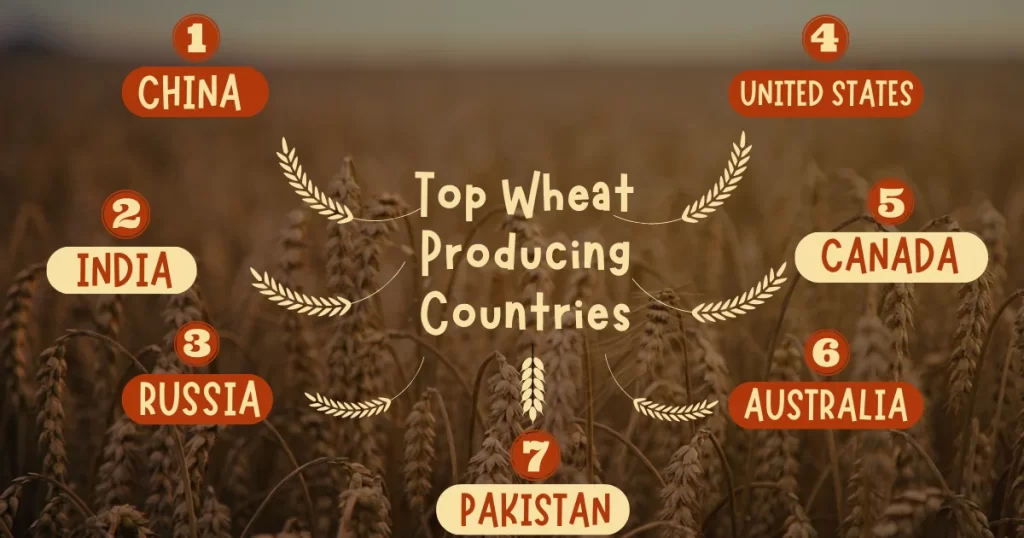
- China: China is the most populated country in the world and produces the most wheat. They have vast agricultural lands in the north where they grow a lot of wheat using advanced techniques and technology. China not only meets its own demand for wheat but also exports a lot to other countries.
- India: India is the second-largest wheat producer. They have different types of climates that support wheat cultivation. Indian farmers use modern methods, and they produce enough wheat for their own needs and also export to other countries.
- Russia: Russia has large areas of fertile land, especially in the southwest, where they grow high-quality wheat. They are one of the leading exporters of wheat because of their efforts to modernize agriculture.
- United States: The United States has been a major player in wheat production for a long time. The Great Plains states like Kansas, North Dakota, and Montana are excellent for growing wheat. The US not only produces enough wheat for itself but also exports a lot to different countries.
- Canada: Canada is also a significant wheat producer with advanced farming techniques. The Canadian Prairies in Alberta, Saskatchewan, and Manitoba are great places for growing wheat. Canada is known for its high-quality wheat and is a reliable exporter.
- Australia: Australia is famous for producing premium quality wheat. They have a region called the wheat belt with a Mediterranean climate that helps produce consistent and high yields. Australia plays a vital role in global wheat trade.
- Pakistan: Pakistan is becoming an important player in the global wheat market. They have fertile areas like the Indus River basin and Punjab region for growing wheat. The government’s focus on agriculture and farmer support has helped increase wheat production in Pakistan.
These countries are the main wheat producers and have a big impact on the global wheat market. They use advanced techniques and technology, and their efforts ensure a steady supply of wheat to feed the world’s growing population.
Comprehensive Analysis about Wheat Rate in Pakistan
Wheat is the most widely cultivated cereal crop in Pakistan, serving as a staple food for the majority of its population. As an essential commodity, the price of wheat plays a crucial role in determining the cost of living and overall food security in the country. In this in-depth analysis, we will explore the multifaceted factors that influence wheat price in Pakistan, their interplay, and the challenges faced by the agricultural sector and the economy at large. Wheat rate in Pakistan too much depends on the following topics:
- Supply and Demand Dynamics
At the core of wheat price fluctuations lie the fundamental principles of supply and demand. Wheat production in Pakistan is primarily dependent on several factors, including climate conditions, water availability, pest management, and technological advancements in agriculture. Any deviation from optimal conditions can lead to variations in crop yields, thereby affecting the supply of wheat in the market.
On the demand side, population growth and changing consumption patterns significantly influence wheat consumption. With a rapidly growing population, the demand for wheat consistently increases. Additionally, shifts in consumer preferences, such as a rising inclination towards processed foods or dietary changes, can also impact the demand for wheat products. So, supply and demand play an important impact on wheat rate in Pakistan.
2. Climate Change and Agricultural Productivity
Climate change poses a significant challenge to the agricultural sector, with Pakistan witnessing various impacts like erratic monsoons, extreme weather events, and rising temperatures. These changes directly affect agricultural productivity, leading to reduced yields and, consequently, affecting the overall supply of wheat and wheat rate in Pakistan.
As climate change continues to be a global concern, Pakistan’s agricultural sector must adapt to sustainable practices that promote resilience and mitigate adverse impacts. Implementing efficient water management techniques, promoting drought-resistant crop varieties, and adopting conservation agriculture can help safeguard wheat production in the face of climate change.
3. Government Policies and Subsidies
The Pakistani government actively intervenes in the wheat market through policies and subsidies aimed at stabilizing prices and supporting farmers. Procurement prices, support prices, and minimum support prices (MSP) are set to ensure that farmers receive fair compensation for their efforts. The government also maintains strategic wheat reserves to manage price volatility and address food crises.
While these policies are crucial for supporting farmers and ensuring food security, there are challenges. Setting wheat price too low may discourage farmers from producing wheat, leading to reduced supply and potential shortages. Conversely, artificially high prices may lead to increased hoarding and black marketing, further exacerbating price fluctuations. If the government apply bad policies, then the wheat rate in Pakistan is affected.
4. International Trade and Wheat Imports
Pakistan is a participant in the global wheat market, and international factors also influence domestic wheat price. In times of domestic shortages, the country may import wheat to meet its demand. However, fluctuations in international prices and trade policies of wheat-exporting countries can impact the cost of imported wheat, subsequently influencing domestic prices.
Changes in global wheat supply and demand, weather events in other wheat-producing countries, and geopolitical factors can all affect the dynamics of international wheat trade and have ripple effects on Pakistan’s wheat market.
5. Transportation and Storage Infrastructure
Efficient transportation and storage infrastructure are essential for the smooth movement and distribution of wheat within the country. Inadequate storage facilities can result in post-harvest losses due to spoilage or pest infestation. Similarly, inefficient transportation systems can cause delays in the movement of wheat from surplus regions to deficit areas, leading to imbalances in supply and demand and affecting prices.
Investing in modern storage facilities and improving transportation networks can help reduce losses, promote a more efficient distribution system, and stabilize wheat prices across regions.
6. Impact of Exchange Rates and Inflation
Exchange rates and inflation also play a role in influencing wheat price. A weaker domestic currency can lead to higher import costs for agricultural inputs like fertilizers and pesticides, impacting production costs for farmers. Inflation, on the other hand, affects the purchasing power of consumers, potentially leading to changes in demand for wheat and its products. So, it affects the wheat rate in Pakistan.
7. Role of Speculation and Market Sentiment
Speculation and market sentiment can also influence wheat price. Traders, investors, and speculators may engage in futures trading or hoarding based on their perceptions of future price movements. This behavior can create price volatility and contribute to short-term fluctuations in wheat prices.
Government regulations and market oversight are crucial to ensure that speculation does not cause unnecessary price distortions and harm the interests of consumers and farmers.
Wheat Production in Pakistan
Wheat is a staple food in Pakistan, serving as a primary source of nutrition for millions of people. The country’s diverse climate, fertile lands, and agricultural expertise have contributed to making Pakistan one of the largest wheat producers in the world. This blog delves into the fascinating journey of wheat production in Pakistan, exploring its significance, challenges, and the strategies employed to boost productivity.
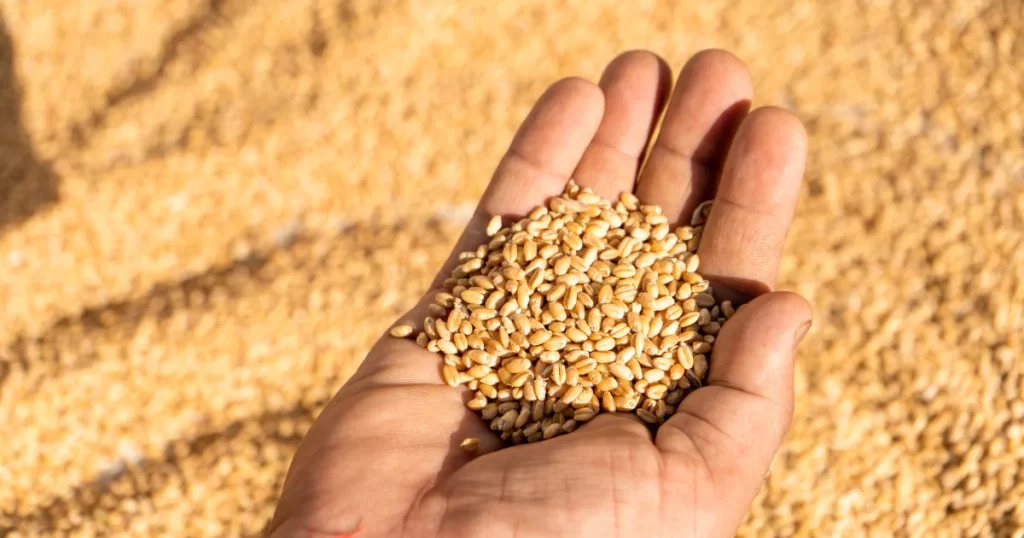
- Importance of Wheat in Pakistan
Wheat is the most important crop in Pakistan, covering a substantial portion of agricultural land. Its significance lies not only in providing a major share of the daily caloric intake for the population but also in being a vital source of income for millions of farmers across the country. In addition to its role in feeding the nation, wheat also contributes significantly to the export sector, generating revenue and boosting the country’s economy.
2. Climatic Conditions and Growing Regions
Pakistan’s diverse topography and climate allow for wheat cultivation across various regions. The major wheat-growing provinces include Punjab, Sindh, Khyber Pakhtunkhwa, and Baluchistan. Each region has its unique climate and soil conditions, enabling farmers to grow different wheat varieties and optimize their production.
3. Varieties of Wheat Cultivated
Several wheat varieties are cultivated in Pakistan, each adapted to specific climatic conditions and farming practices. Some of the popular wheat varieties include:
a) Sehar-2006: Known for its early maturity and resistance to diseases.
b) Inqilab-91: A high-yielding variety suitable for diverse climates.
c) Punjab-96: Famous for its excellent baking quality.
d) Saleem-2000: Preferred for its resistance to rust and lodging.
Many other wheat varieties introduced such as Arooj 2022, Subhani 2021, Dilkash 2020, Akbar 2019, Anaj 2017, Ujala 2016, Galaxy 2013, Lasani 2008, FSD. 08 and too many others.
4) Challenges in Wheat Production
Despite its prominence, wheat production in Pakistan faces various challenges that hinder its optimal growth and potential. Some of the major challenges include:
a) Water Scarcity: The availability of water resources for irrigation is limited, affecting wheat production in arid regions.
b) Outdated Farming Practices: Traditional farming methods prevail in some areas, reducing overall productivity.
c) Pest and Disease Management: Controlling wheat pests and diseases remains a constant battle for farmers.
d) Climate Change: Erratic weather patterns and extreme temperatures pose risks to wheat crops.
5. Government Initiatives and Technological Advancements
Recognizing the significance of wheat production, the government of Pakistan has implemented several initiatives to support and boost the industry. Some of these measures include:
a. Subsidies and Incentives: The government provides subsidies on fertilizers, seeds, and pesticides to reduce the cost burden on farmers.
b. Research and Development: Investments in agricultural research help in developing new wheat varieties that are more resilient and higher-yielding.
c. Modernization of Farming: Encouraging the adoption of modern agricultural practices and machinery to enhance productivity.
d. Irrigation Management: Implementing efficient irrigation systems to conserve water resources.
6. Future Prospects
Despite the challenges, the future of wheat production in Pakistan looks promising. Continued government support, advancements in agricultural technologies, and the resilience of farmers are key factors that will contribute to sustaining and increasing wheat yields. Moreover, efforts to address climate change through sustainable practices and water management will play a pivotal role in ensuring food security in the nation.
Analyzing the Role of Wheat Production in Pakistan’s GDP Growth
Wheat production has historically played a significant role in Pakistan’s GDP growth and remains an essential sector of the country’s economy. Agriculture, in general, is a crucial component of Pakistan’s economy, and wheat is the most important staple crop in the country.
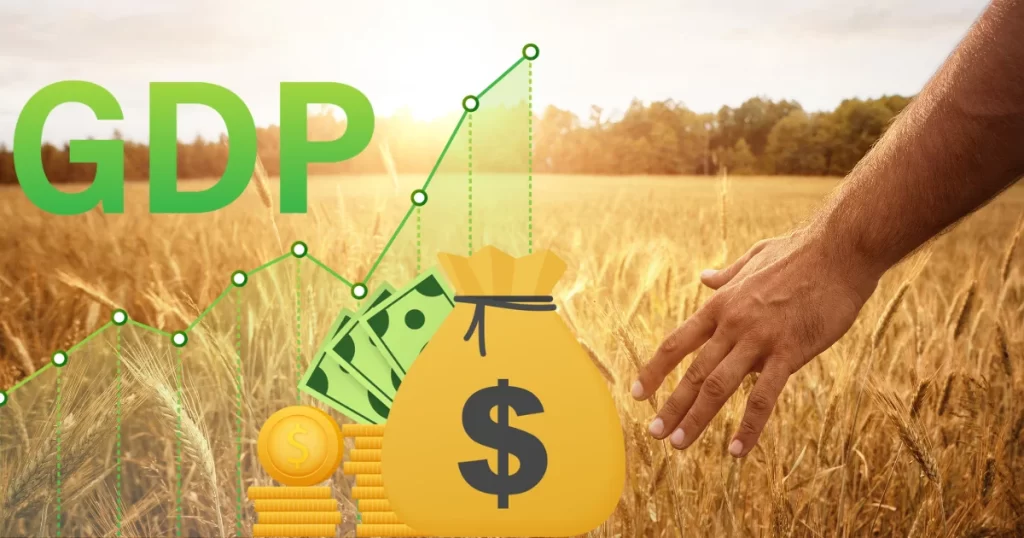
Here are some key points highlighting the role of wheat production in Pakistan’s GDP growth:
- Contribution to GDP: Agriculture, including wheat production, contributes a substantial share to Pakistan’s GDP. In the past, agriculture has contributed around 20% to 25% of the country’s GDP, making it one of the largest sectors in the economy.
- Employment: The agriculture sector, including wheat farming, is a significant source of employment in Pakistan, providing jobs for a substantial portion of the population. Many rural communities depend on wheat farming for their livelihood.
- Food Security: Wheat is a staple food in Pakistan, and it forms a critical component of the average Pakistani’s diet. As a result, a consistent and reliable wheat production system is vital for ensuring food security in the country.
- Export Potential: Pakistan is one of the world’s leading wheat producers, and surplus production allows for exports to international markets. Wheat exports can bring in foreign exchange earnings and positively impact the country’s trade balance.
- Rural Economy: Wheat production supports the rural economy by generating income for farmers, stimulating demand for inputs such as seeds and fertilizers, and supporting various ancillary industries like transportation and food processing.
- Government Policies: The government of Pakistan has historically supported agriculture, including wheat production, through various policies, subsidies, and incentives. These measures aim to enhance productivity, increase yields, and ensure farmers’ welfare.
- Price Stability: Wheat production has a direct impact on price stability within the domestic market. Adequate production helps in controlling food inflation, which can have far-reaching effects on the overall economy and the population’s well-being.
- Challenges: Despite its importance, the wheat sector in Pakistan faces various challenges, including water scarcity, outdated agricultural practices, climate change impact, and pest and disease issues. Addressing these challenges is crucial for sustaining and further boosting wheat production and its positive impact on the economy.
It’s important to note that while wheat production has historically been significant for Pakistan’s economy, the role of other sectors, such as services and industry, has been increasing over the years. As the country develops and diversifies its economy, the relative contribution of wheat production to GDP growth might change.
Big Challenges to Pakistan in Wheat Production
Wheat is a very important crop in Pakistan and plays a big role in its farming economy. The country depends a lot on wheat to feed its large population and support the many farmers who grow it. However, even though Pakistan is one of the top wheat producers in the world, it faces several problems that make it hard to grow enough wheat. In this blog, we will talk about some of the main challenges Pakistan deals with in growing wheat and look at some ideas to solve these problems.
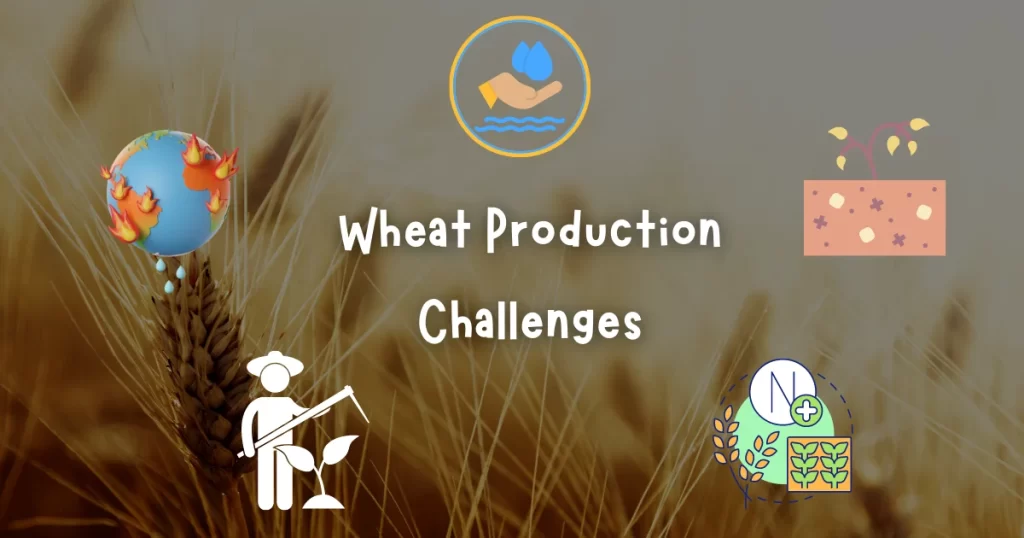
- Water Scarcity
One of the most significant challenges to wheat production in Pakistan is water scarcity. The country’s irrigation system primarily depends on the Indus River and its tributaries, which have been facing reduced water flow due to climate change and the construction of dams in neighboring countries. This results in insufficient water availability for wheat crops, especially during critical growth stages.
Solution: Implementing efficient irrigation techniques, such as drip irrigation and sprinkler systems, can help conserve water and improve its distribution. Additionally, investing in water storage infrastructure and rainwater harvesting methods can mitigate the impact of water scarcity on wheat production.
2. Outdated Farming Practices
Many farmers in Pakistan continue to employ traditional and outdated farming practices, limiting their wheat yield potential. The reliance on age-old techniques, along with inadequate access to modern agricultural technology and knowledge, hampers productivity.
Solution: Initiatives to promote agricultural education and extension services can help educate farmers about modern farming practices, including the proper use of fertilizers, pesticides, and advanced machinery. Government and non-government organizations should collaborate to provide training programs and demonstrations to showcase the benefits of adopting modern agricultural techniques.
3. Soil Degradation
Soil degradation is another significant challenge facing Pakistan’s wheat production. Continuous cultivation without adequate soil management practices leads to nutrient depletion and decreased soil fertility. Erosion further exacerbates the problem, causing soil to lose its ability to support healthy wheat growth.
Solution: Encouraging the adoption of sustainable agricultural practices, such as crop rotation, organic farming, and no-till farming, can help restore soil health and fertility. Additionally, promoting the use of organic and bio-fertilizers can reduce reliance on synthetic chemicals and contribute to long-term soil preservation.
4. Climate Change Impact
Climate change poses a serious threat to Pakistan’s agriculture, including wheat production. Erratic weather patterns, frequent droughts, heatwaves, and extreme rainfall events can negatively impact wheat yields and result in crop failures.
Solution: To mitigate the impact of climate change, the government must invest in climate-resilient crop varieties that are adapted to changing environmental conditions. Promoting climate-smart agriculture techniques, such as water-efficient and heat-tolerant wheat varieties, can help farmers withstand the challenges posed by a changing climate.
5. Pest and Disease Management
Wheat crops in Pakistan are susceptible to various pests and diseases, such as rusts, aphids, and Hessian fly. Inadequate pest and disease management practices can lead to significant yield losses.
Solution: Establishing an effective pest and disease monitoring system, along with promoting integrated pest management (IPM) practices, can help farmers detect potential issues early and implement appropriate control measures. IPM combines biological, chemical, and cultural methods to manage pests and diseases sustainably.
Understanding How Wheat Prices Fluctuate?
The price of wheat fluctuates due to a combination of various factors that influence its supply and demand dynamics. Some of the key factors that impact the price of wheat include:

- Weather Conditions: Wheat is a crop highly sensitive to weather conditions, particularly during planting, growing, and harvesting seasons. Adverse weather events such as droughts, floods, extreme temperatures, or frost can damage crops and reduce yields, leading to decreased supply and higher prices.
- Global Supply and Demand: Changes in global supply and demand for wheat can significantly affect its price. Increased demand from growing populations, changing dietary habits, or expanding livestock industries can drive prices higher. Conversely, higher production and abundant supply can lead to lower prices.
- Production Levels and Crop Yields: The level of wheat production in major producing countries plays a crucial role in determining its price. Higher yields and robust production can lead to surplus supply and lower prices. On the other hand, lower yields due to various factors can cause prices to rise.
- Government Policies: Government interventions, such as subsidies, import/export tariffs, and trade restrictions, can influence wheat prices. For example, export restrictions in wheat-exporting countries can reduce global supply and drive prices higher, while subsidies can support farmers and lead to increased production.
- Transportation and Storage Costs: The cost of transporting wheat from producing regions to consuming areas and the expense of storage facilities can impact its final price for consumers.
- Currency Exchange Rates: Wheat is a globally traded commodity, and its price can be affected by fluctuations in exchange rates. A weaker currency in a major exporting country can make its wheat cheaper for foreign buyers, increasing demand and potentially raising prices.
- Competition from Other Crops: Wheat competes with other grains and crops for agricultural land and resources. Changes in planting decisions by farmers, influenced by relative profitability and market demand for various crops, can affect wheat supply levels and prices.
- Economic Factors: Economic conditions, such as overall economic growth, inflation, and income levels, can influence the demand for wheat-based products. During economic downturns, demand for certain wheat products may decrease, affecting prices.
- Speculation and Futures Markets: Trading in wheat futures and speculation by investors and traders can lead to short-term price fluctuations that may not necessarily reflect the underlying supply and demand fundamentals.
It’s important to note that the wheat market is complex, and these factors can interact in various ways, causing price fluctuations that can be difficult to predict with certainty. Farmers, traders, governments, and consumers all play a role in shaping the dynamics of the wheat market. That is why all factors play an important role in wheat rate in Pakistan.
Impact of Government Subsidies on Wheat Rate in Pakistan
Government subsidies can have a significant impact on wheat rates in Pakistan, affecting both producers and consumers in the country. Here are some of the key ways in which government subsidies can influence wheat prices or wheat rate in Pakistan:
- Price Support for Farmers: Government subsidies on inputs like fertilizers, seeds, and irrigation can reduce the cost of production for wheat farmers. This encourages increased wheat cultivation and helps to stabilize or boost domestic wheat production. When farmers face lower production costs, they may be more willing to sell their wheat at lower prices, which can help keep wheat rates in check.
- Procurement Prices: Many governments, including Pakistan, implement a system of procurement at minimum support prices (MSP) for essential commodities like wheat. The government purchases wheat from farmers at a guaranteed price, often higher than the prevailing market price. This price assurance gives farmers an incentive to produce more wheat and contributes to price stability in the market.
- Consumer Subsidies: In some cases, the government provides subsidies directly to consumers to lower the cost of purchasing wheat-based products, such as flour or bread. This can help alleviate the burden of high wheat rates on the general population, especially vulnerable groups who spend a significant portion of their income on food.
- Buffer Stock Management: With subsidies, the government may maintain a strategic buffer stock of wheat to mitigate the impact of price fluctuations due to factors like weather conditions or global market changes. By releasing wheat from the buffer stock during periods of scarcity, the government can stabilize wheat rates and ensure a steady supply in the market.
- Inflation Control: Wheat is a staple food in Pakistan, and fluctuations in its price can have a cascading effect on food inflation. Government subsidies on wheat can help control overall inflation rates by stabilizing food prices, thereby contributing to overall economic stability. So, inflation impacts directly on wheat rate in Pakistan.
However, it’s important to note that while subsidies can have short-term benefits, they may also lead to some unintended consequences:
- Fiscal Burden: Government subsidies can put a strain on the national budget, especially if they are not managed efficiently. Subsidies may lead to budget deficits, affecting the overall financial health of the country.
- Market Distortions: Artificially low wheat rates due to subsidies may discourage private investment in agriculture and reduce the competitiveness of the sector. This can have long-term negative impacts on agricultural productivity and growth.
- Black Market Activity: In some cases, subsidies may create opportunities for black market activity, where subsidized wheat is diverted to illegal channels for higher profits. When subsidized wheat is not delivered to the right people, then wheat rate in Pakistan are also affect.
In conclusion, government subsidies can play a crucial role in stabilizing wheat rate in Pakistan, benefiting both producers and consumers. However, their effectiveness depends on proper implementation and management to avoid unintended consequences and ensure sustainable economic growth.
Impact of Internal and Global Markets on Wheat Rate in Pakistan
The wheat rate in Pakistan, like in many other countries, can be influenced by various factors, including both internal and global market dynamics. Here’s an overview of how these factors can impact the wheat rate in Pakistan:
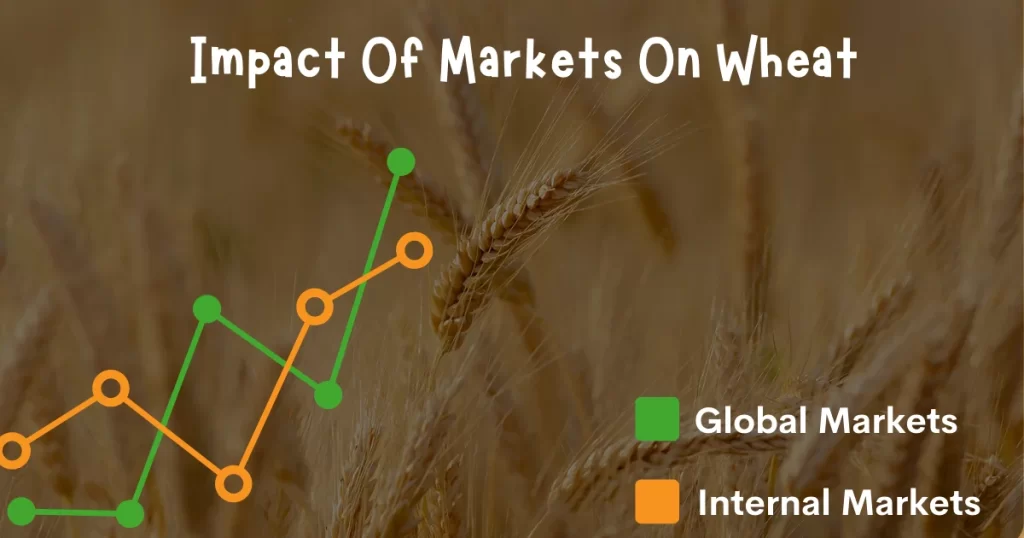
- Internal Factors:
A) Domestic Production: The most significant internal factor affecting wheat rate in Pakistan is the domestic production of wheat. Pakistan is a major wheat-producing country, and the level of production directly impacts the supply of wheat in the domestic market. Higher production leads to increased supply, which can exert downward pressure on wheat prices. Conversely, lower production may lead to reduced supply and potentially result in higher wheat prices.
B) Government Policies: Government policies such as wheat subsidies, import/export regulations, and support prices can significantly impact wheat rates. Subsidies can lower the cost of production and stabilize prices, while import/export regulations can influence the availability of wheat in the domestic market. The government’s support price policy provides a minimum price to farmers for their wheat, which can affect market rates.
C) Weather Conditions: Weather plays a crucial role in agriculture, and wheat production is highly dependent on favorable weather conditions. Droughts, floods, or other adverse weather events can negatively affect wheat crops, leading to reduced yields and potentially higher prices due to supply constraints. That’s why it affects the wheat rate in Pakistan.
D) Transportation and Storage Infrastructure: Efficient transportation and storage infrastructure are essential to ensure the smooth flow of wheat from production centers to consumption areas. Poor infrastructure can lead to bottlenecks and increase transportation costs, affecting wheat prices.
2. Global Factors:
A) International Demand and Supply: Pakistan is not only a wheat producer but also a wheat importer and exporter. Global demand and supply dynamics can impact wheat rates in the country. For example, if there is a shortage of wheat in the international market, it may lead to higher import costs for Pakistan, influencing domestic prices.
B) Global Wheat Price: International wheat prices can directly impact the wheat rate in Pakistan, especially when the country relies on imports. High global prices may lead to higher import costs, which can then affect domestic prices.
C) Currency Exchange Rates: Exchange rate fluctuations can influence the cost of wheat imports and exports. A weaker Pakistani Rupee against major trading currencies can increase import costs, potentially impacting domestic wheat prices.
D) Trade Agreements and Tariffs: Trade agreements and tariffs between Pakistan and other wheat-producing and consuming countries can influence the flow of wheat across borders, impacting the domestic supply and demand situation and, consequently, the wheat rate.
In summary, the wheat rate in Pakistan is subject to the interplay of various internal and global factors, including domestic production, government policies, weather conditions, international demand and supply, global wheat prices, currency exchange rates, and trade agreements. These factors collectively determine the availability, cost, and pricing of wheat in the country.
Conclusion
In conclusion, Wheat rate in Pakistan is between 3,200 and 3,800 Rs per 40 kg. In the wheat season 2024. Farmers suffered huge losses due to wheat sales not being at control rate. The dynamics of wheat prices in Pakistan have been thoroughly analyzed, considering various factors that influence its rate in the country. Within Pakistan, wheat production plays a crucial role in the country’s GDP growth, indicating its economic importance.
FAQs
What is the wheat government rate in Punjab 2024?
At the beginning of the wheat season 2024, the government had fixed the price of wheat at 3,900 Rs. But later the government further reduced the price of wheat to 2,800 Rs per 40 kg.
What is the price of 40 kg wheat in Pakistan today 2025?
Today, the wheat price in Pakistan per 40 kg is between 3,200 and 3,800 Rs.
What is the price of 1 kg of wheat in Pakistan?
The average price of 1 kg wheat is 88 Rs.
Why is the wheat price going down?
Due to the government not buying wheat from the farmers, the price of wheat decreased day by day. At the beginning of the 2024 season, the government fixed the price of wheat at 3,900 Rs, but later changed it to 2,800 Rs. Due to bad strategy and incompetent policies of the government, the price of wheat decreased.

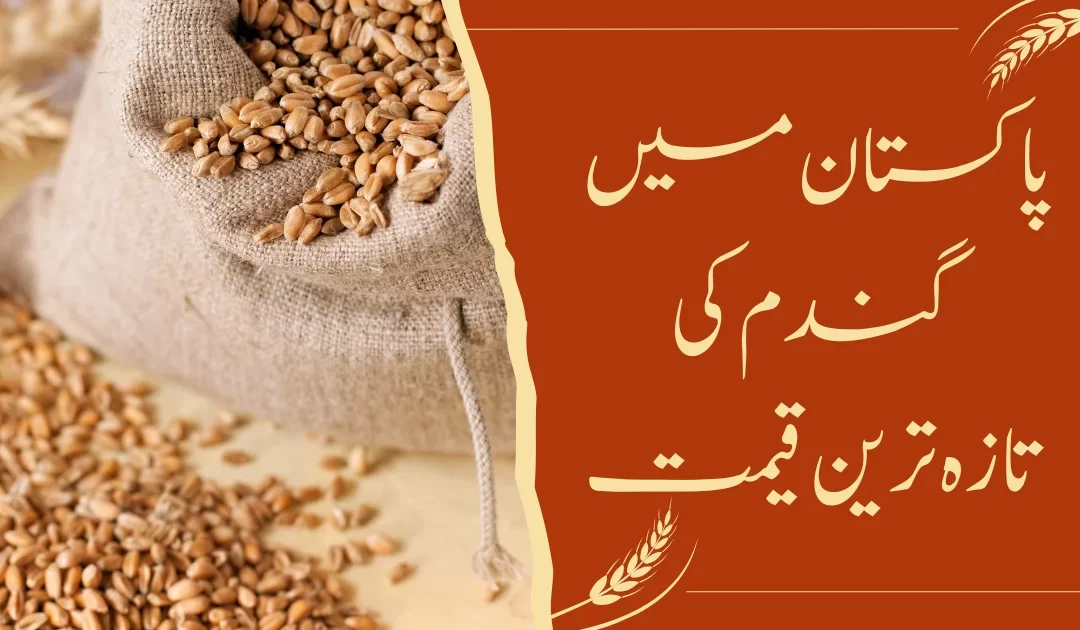
I am a farmer
Okay ????????????????????
Lanat chor government pr.ye inki ghinaoni saazish hay .coz Pakistan aik agricultural mulk hay.ye kisan ko iss hdd tkk majboor kr dain gay k kisan faslain ugana chor dain aur ye america aur dosray mumalik k saamnay surkharo hojaye k hmm nay aapki Marzi k mutabiq Pakistani maeeshat kamzor kr di.jb fasal lga rhay hotay hain tbb tu khaad spray aur dosribcheezon ko 100 guna rate barha kr dete hain.jb kisan apnay khon paseena aik kr k fasal ugaa rha hota hay .jb fasal pkk jati hay tu maalik bn jaatay hain.
What is supported price in Punjab Pakistan today?
3900 Rs
Kitni chaya gandam 3900kaa isang saa 03476462022
120kg
Wheat rate in 2024
Haye, Kissan Rull gaye…
price in punjab pakistan today?
If we need wheat or A1 quality
Then you can transport us
Minimum 300 Bags we deliver
Dap and sona price details.
Sir oper price mention ki gae hy, Thanks
Aoa huzafia plz contact I have wheat 03012225636 thanks
yes 03007334988
aj gandam ka kiya rate ha
Thanks for update
good information
Thanks sir
Does anybody need the best quality Wheat?
Contact at: 03155937817
What is rate of wheat 40 kg District Kasur ? Reply me on contact #03007571732
kindly oper die rates check krai